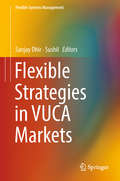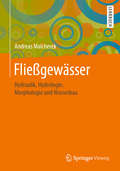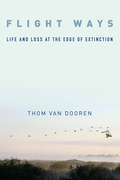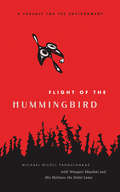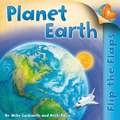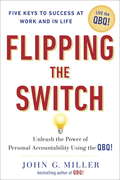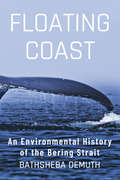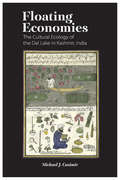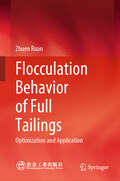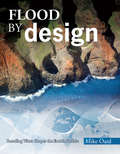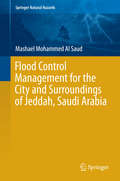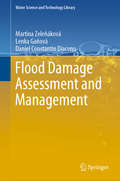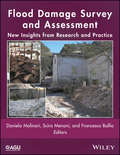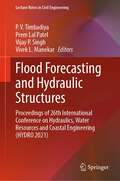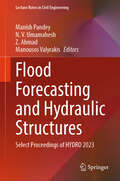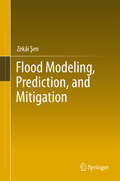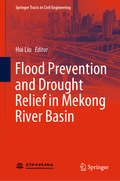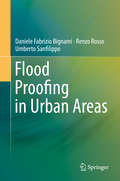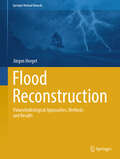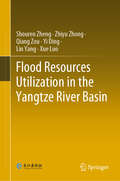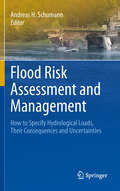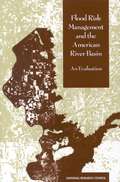- Table View
- List View
Flexible Strategies in VUCA Markets (Flexible Systems Management)
by Sushil Sanjay DhirThis book discusses the concepts of volatility, uncertainty, complexity, and ambiguity (VUCA) that are the core of various paradigms used in strategic management to understand competitive advantage as well as flexibility in organizational boundaries. It serves as a valuable reference resource in the area of VUCA markets. An increase in the levels and types of uncertainty has important implications potentially for the durability of a company’s advantages, the way firms learn and adapt, approaches for managing innovation and knowledge, and the attractiveness of different strategies and organizational models. In today’s world, strategic flexibility in VUCA is essential for business leaders to sustain market advantage and attain a clear vision amid the chaos. Business leaders who stay focused and are aware of external volatility as the prevalent characteristic are successful, while those who are not flexible in this VUCA world and lock themselves into fixed positions lose out.The book includes empirical and conceptual research papers along with case studies and models discussing strategies for emerging markets in volatile and uncertain environments. It also covers a variety of issues, including innovation, people and processes, financial management, and leadership and strategies in VUCA markets. Apart from research fraternity and academia, the contents of the book will be useful for practitioners as well as industry watchers.
Fließgewässer- und Auenentwicklung: Grundlagen und Erfahrungen
by Werner Konold Peter Meyer Stephan Von Keitz Walter Binder Mario Sommerhäuser Michael Schirmer Klaus Arzet Birgit Beckers Hubertus Brückner Holger Brux Dieter Coldewey Alexandra Dehnhardt Ulrich Detering Sebastian Döbbelt-Grüne Joachim Drüke Thomas-Ols Eggers Klaus-Dieter Fröhlich Christian Göldi Josef Groß Anja Kaussow Ellen Kiel Uwe Koenzen Annette Kurth Roland Loerbroks Helmut Mader Dietmar Mehl Thomas Paulus Tanja Pottgieser Bernd Schackers Jörg Scholle Georg Schrenk Peter Sellheim Mechtild Semrau Simon Spinner Eberhard Städtler Bernd Walser Klaus Werk Michael WeyandDieses Fachbuch erläutert die Grundlagen für die Entwicklung von Fließgewässern und Gewässerauen und hilft dabei an den Erfahrungen der Autoren teilzuhaben. Aktuelle Vorgehensweisen zum Umgang mit einer dynamischen Gewässer- und Auenentwicklung werden nachvollziehbar dargestellt und durch zahlreiche Beispiele aus unterschiedlichen Gewässerlandschaften ergänzt. Zur Erreichung der ambitionierten Ziele der Europäischen Wasserrahmenrichtlinie (WRRL) sind die gewässerökologischen, naturschutzfachlichen und hydromorphologischen Bedingungen (u.a. Hoch- und Niedrigwasser) im Gewässerkörper und in den angrenzenden Bereichen (u.a. die Gewässerauen), bei der Planung und Gestaltung zu berücksichtigen. Eine ganzheitliche Betrachtungsweise ist dabei Grundvoraussetzung.
Fließgewässer: Hydraulik, Hydrologie, Morphologie und Wasserbau
by Andreas MalcherekDas vorliegende Buch vermittelt Studierenden die hydrologischen, hydraulischen und wasserbaulichen Grundlagen für Gerinne und Fließgewässer. Mit den Programmierbeispielen können die Inhalte geübt und vertieft werden.
Flight Ways
by Thom Van DoorenA leading figure in the emerging field of extinction studies, Thom van Dooren puts philosophy into conversation with the natural sciences and his own ethnographic encounters to vivify the cultural and ethical significance of modern-day extinctions. Unlike other meditations on the subject, Flight Ways incorporates the particularities of real animals and their worlds, drawing philosophers, natural scientists, and general readers into the experience of living among and losing biodiversity.Each chapter of Flight Ways focuses on a different species or group of birds: North Pacific albatrosses, Indian vultures, an endangered colony of penguins in Australia, Hawaiian crows, and the iconic whooping cranes of North America. Written in eloquent and moving prose, the book takes stock of what is lost when a life form disappears from the world -- the wide-ranging ramifications that ripple out to implicate a number of human and more-than-human others. Van Dooren intimately explores what life is like for those who must live on the edge of extinction, balanced between life and oblivion, taking care of their young and grieving their dead. He bolsters his studies with real-life accounts from scientists and local communities at the forefront of these developments. No longer abstract entities with Latin names, these species become fully realized characters enmeshed in complex and precarious ways of life, sparking our sense of curiosity, concern, and accountability toward others in a rapidly changing world.
Flight Ways: Life and Loss at the Edge of Extinction
by Thom Van DoorenA leading figure in the emerging field of extinction studies, Thom van Dooren puts philosophy into conversation with the natural sciences and his own ethnographic encounters to vivify the cultural and ethical significance of modern-day extinctions. Unlike other meditations on the subject, Flight Ways incorporates the particularities of real animals and their worlds, drawing philosophers, natural scientists, and general readers into the experience of living among and losing biodiversity.Each chapter of Flight Ways focuses on a different species or group of birds: North Pacific albatrosses, Indian vultures, an endangered colony of penguins in Australia, Hawaiian crows, and the iconic whooping cranes of North America. Written in eloquent and moving prose, the book takes stock of what is lost when a life form disappears from the world -- the wide-ranging ramifications that ripple out to implicate a number of human and more-than-human others. Van Dooren intimately explores what life is like for those who must live on the edge of extinction, balanced between life and oblivion, taking care of their young and grieving their dead. He bolsters his studies with real-life accounts from scientists and local communities at the forefront of these developments. No longer abstract entities with Latin names, these species become fully realized characters enmeshed in complex and precarious ways of life, sparking our sense of curiosity, concern, and accountability toward others in a rapidly changing world.
Flight Ways: Life and Loss at the Edge of Extinction (Critical Perspectives on Animals: Theory, Culture, Science, and Law)
by Thom van DoorenA leading figure in the emerging field of extinction studies, Thom van Dooren puts philosophy into conversation with the natural sciences and his ethnographic encounters to vivify the cultural and ethical significance of modern-day extinctions. Unlike other meditations on the subject, Flight Ways incorporates the particularities of real animals and their worlds, drawing philosophers, natural scientists, and general readers into the experience of living among and losing biodiversity.Each chapter of Flight Ways focuses on a different species or group of birds: North Pacific albatrosses, Indian vultures, an endangered colony of penguins in Australia, Hawaiian crows, and the iconic whooping cranes of North America. Written in eloquent and moving prose, the book takes stock of what is lost when a life form disappears from the world—the wide-ranging ramifications that ripple out to implicate a number of human and more-than-human others. Van Dooren intimately explores what life is like for those who must live on the edge of extinction, balanced between life and oblivion, taking care of their young and grieving their dead. He bolsters his studies with real-life accounts from scientists and local communities at the forefront of these developments. No longer abstract entities with Latin names, these species become fully realized characters enmeshed in complex and precarious ways of life, sparking our sense of curiosity, concern, and accountability toward others in a rapidly changing world.
Flight of the Hummingbird
by Wangari Maathai The Dalai Lama Michael Nicoll YahgulanaasHummingbirds have long been a symbol of wisdom and courage. In this charming story, a hummingbird makes a valiant effort to put out a raging fire that threatens her forest home - trip after trip, her beak is filled each time with just a drop of water. Her efforts show her woodland companions that doing something - anything - is better than doing nothing at all. The hummingbird parable, which originates with the Quechuan people of South America, has become a talisman for environmentalists and activists worldwide committed to making meaningful change. This retelling, enlivened by Michael Nicoll Yahgulanaas' fabulous Haida-manga illustrations, is suitable for all ages of would-be activists. Although environmental responsibility often seems like an overwhelming task, The Flight of the Hummingbird shows how easy it is to start and how great the effect could be if everyone just did what they could.
Flip The Flaps: Planet Earth
by Mike Goldsmith Nicki PalinInFlip The Flaps: Planet Earth by Dr Mike Goldsmith, illustrated by Nicki Palin, children zoom up through protective layers of the atmosphere from the surface to outer space, following the Earth as it makes its yearly journey around the Sun. Young explorers lift the flaps to reveal answers about everything from the inner workings of our planet and why volcanoes erupt to finding animals in the forests and in the sea. Plus, a fun spot-the-difference game suddenly appears as the artwork amazingly changes.
Flipping the Switch...: Unleash the Power of Personal Accountability Using the QBQ!
by John G. MillerIn his bestselling book QBQ! The Question Behind the Question, John G. Miller revealed how personal accountability helps to create opportunity, overcome obstacles, and achieve goals by eliminating blame, complaining, and procrastination. The result? Stronger organizations, more dynamic teams, and healthier relationships. Now Miller takes readers to the next level to show how they can use the power of the QBQ! and personal accountability every day. When a light switch is flipped the flow of energy that is released reaches the lightbulb in an instant, bringing it to life. Similarly, asking the right kind of question-a QBQ-is the first step to empowering what Miller calls the Advantage Principles-five essential practices that will lead to a richer experience in every aspect of life: - LEARNING: live an engaged and energized life through positive personal growth and change - OWNERSHIP: attain goals by becoming a solution-oriented person who solves problems - CREATIVITY: find new ways to achieve by succeeding "within the box" - SERVICE: build a legacy by helping others succeed - TRUST: develop deep and rewarding relationships With compelling real-life stories and keen insights, Miller demonstrates how anyone can find success and satisfaction by "flipping the switch."
Floating Coast: An Environmental History Of The Bering Strait
by Bathsheba DemuthA groundbreaking exploration of the relationship between capitalism, communism, and Arctic ecology since the dawn of the industrial age. Whales and walruses, caribou and fox, gold and oil: through the stories of these animals and resources, Bathsheba Demuth reveals how people have turned ecological wealth in a remote region into economic growth and state power for more than 150 years. The first-ever comprehensive history of Beringia, the Arctic land and waters stretching from Russia to Canada, Floating Coast breaks away from familiar narratives to provide a fresh and fascinating perspective on an overlooked landscape. The unforgiving territory along the Bering Strait had long been home to humans—the Inupiat and Yupik in Alaska, and the Yupik and Chukchi in Russia—before Americans and Europeans arrived with revolutionary ideas for progress. Rapidly, these frigid lands and waters became the site of an ongoing experiment: How, under conditions of extreme scarcity, would the great modern ideologies of capitalism and communism control and manage the resources they craved? Drawing on her own experience living with and interviewing indigenous people in the region, as well as from archival sources, Demuth shows how the social, the political, and the environmental clashed in this liminal space. Through the lens of the natural world, she views human life and economics as fundamentally about cycles of energy, bringing a fresh and visionary spin to the writing of human history. Floating Coast is a profoundly resonant tale of the dynamic changes and unforeseen consequences that immense human needs and ambitions have brought, and will continue to bring, to a finite planet.
Floating Economies: The Cultural Ecology of the Dal Lake in Kashmir, India
by Michael J. CasimirIn the Himalayas of the Indian part of Kashmir three communities depend on the ecology of the Dal lake: market gardeners, houseboat owners and fishers. Floating Economies describes for the first time the complex intermeshing economy, social structure and ecology of the area against the background of history and the present volatile socio-political situation. Using a holistic and multidisciplinary approach, the author deals with the socioeconomic strategies of the communities whose livelihoods are embedded here and analyses the ecological condition of the Dal, and the reasons for its progressive degradation.
Flocculation Behavior of Full Tailings: Optimization and Application
by Zhuen RuanThis book focuses on the flocculation behavior of full tailings, analyzes the influence of multiple factors such as flow field shear on flocculation behavior, constructs a dynamic model of full tailings flocculation behavior, simulates and studies the flocculation behavior of full tailings in the feedwells of deep cone thickener, and optimizes the feeding and internal flocculation parameters. This book can be read by researchers, designers, and engineering technicians related to backfill mining, as well as by teachers and students of mining majors in universities.
Flood By Design
by Michael OardThere are features on the earth's surface that science cannot explain with theories of changes over millions or even billions of years by the geographic processes that we see occurring commonly today. However, when you explore the evidence from a biblical worldview, the geological features marking the planet's surface make sense given the worldview catastrophic flood described in the book of Genesis. Join author Mike Oard as he explores what is termed as "the retreating stage of the flood" - the seven month-period when the waters receded and the landscapes which are familiar to us were formed by a myriad of processes like uplifts and sinking, erosion, and more, which answer important questions regarding: Unusual dispersals of rocks over hundred of miles How quickly mountains and valleys were carved Emergence of continents and the formation of ocean basins Percussions marks shaped by vast and violently moving water Why very gradual erosion and deposits of soil cannot explain surface formations The study of geomorphology and what it can reveal Flood by Design takes you into a fascinating aspect of the Genesis flood you may never have considered. Examine unusual rock formations and evidence that only the biblical flood model can fully explain. Filled with many photographs and easy-to-understand illustrations and charts, the books is a powerful source of research and answers for high school students and beyond.
Flood Control Management for the City and Surroundings of Jeddah, Saudi Arabia
by Mashael Mohammed Al SaudDuring the past years, Saudi Arabia has been affected by particularly severe torrential rains and floods. This book presents an in-depth and all-encompassing study on the floods that occurred in the Jeddah area in 2009 and 2011, including water-flow mechanisms, state-of-the-art techniques for flood assessment, flood control and appropriate management approaches. It highlights a number of methods and concepts that can be applied in similar areas in Saudi Arabia in order to reduce and mitigate the impact of torrential rains and floods.
Flood Damage Assessment and Management (Water Science and Technology Library #94)
by Martina Zeleňáková Lenka Gaňová Daniel Constantin DiaconuThis book presents state-of-the-art, essential methods and tools for flood risk assessment and management. The costs of damage caused by extreme weather events, among which floods are a major category, are rapidly rising, both globally and across Europe. The scope and scale of flood episodes point to the need for comprehensive proposals, including the implementation of flood protection measures in areas exposed to flood risk. This book is dedicated to flood damage assessment, and addresses the management of social, economic and environmental damage. It develops a general methodology for flood risk assessment and presents a range of effective flood protection methods in keeping with the objectives of flood risk management. As such, it offers a valuable resource for young researchers, academics, lecturers and water management practitioners alike.
Flood Damage Survey and Assessment: New Insights from Research and Practice
by Scira Menoni Daniela Molinari Francesco BallioSeveral scholars across the globe identified the present lack of high quality damage data as the main constraint to efficient risk mitigation. The need for a systematic collection of damage data in the aftermath of flood events come into light, thus the aim being the creation of complete and reliable databases. Flood damage data collected in the aftermath of a disastrous event can support a variety of actions, which include: (i) the identification of priorities for intervention during emergencies, (ii) the creation of complete event scenarios on the basis of which understanding the fragilities of the flooded areas and tailoring risk mitigation strategies, (iii) the definition of victims compensation schemes, and (iv) the validation/definition of damage models to feed cost-benefit analysis of structural and non-structural mitigation actions (including insurance schemes). Volume highlights include: A good compilation of real world case studies elaborating on the survey experiences and best practices associated with flood damage data collection, storage and analysis, that can help strategize flood risk mitigation in an efficient manner Valuable contributions covering different flooding phenomena such as riverine and mountain floods, different spatial level of analysis from local to global scales, and different stakeholders perspectives, e.g. public decision makers, researchers, private companies Contributions from leading experts in the field, researchers and practitioners, including civil protection actors working at different spatial and administrative level, insurers and professionals working in the field of natural hazards mitigation Flood Damage Survey and Assessment: New Insights from Research and Practice will be a valuable resource to all earth scientists, hydrologists, meteorologists, geologists, geographers, civil engineers, insurers and policy decision makers.
Flood Forecasting and Hydraulic Structures: Proceedings of 26th International Conference on Hydraulics, Water Resources and Coastal Engineering (HYDRO 2021) (Lecture Notes in Civil Engineering #340)
by Vijay P. Singh P. V. Timbadiya Prem Lal Patel Vivek L. ManekarThis book comprises the proceedings of the 26th International Conference on Hydraulics, Water Resources and Coastal Engineering (HYDRO 2021) focusing on broad spectrum of emerging opportunities and challenges in the field of flood forecasting and hydraulic structures. It covers a range of topics, including, but not limited to, early warning system, urban flood modelling and management, dam hazard classification, river training and protection works, structural and non-structural measures for flood mitigation, assessment and development of flood vulnerability, hazard and risk maps rehabilitation of old dams, streamflow turbines, canal operation and related structure, operation and management of dams including their instrumentation etc.Presenting recent advances in the form of illustrations, tables, and text, it offers readers insights for their own research. In addition, the book addresses fundamental concepts and studies in the field of flood forecasting and hydraulic structures, making it a valuable resource for both beginners and researchers wanting to further their understanding of hydraulics, water resources and coastal engineering.
Flood Forecasting and Hydraulic Structures: Select Proceedings of HYDRO 2023 (Lecture Notes in Civil Engineering #546)
by Manish Pandey N. V. Umamahesh Z. Ahmad Manousos ValyrakisThis book presents the select proceedings of the 28th International Conference on Hydraulics, Water Resources, River and Coastal Engineering (HYDRO 2023) focusing on broad spectrum of emerging opportunities and challenges in the field of flood forecasting and hydraulic structures. It covers a range of topics, including early warning system, urban flood modelling and management, dam hazard classification, river training and protection works, and structural and non-structural measures for flood mitigation, assessment, and development of flood vulnerability. The book also presents latest developments in topics such as hazard and risk maps rehabilitation of old dams, streamflow turbines, canal operation and related structure, and operation and management of dams, including their instrumentation. Presenting recent advances in the form of illustrations, tables, and text, it offers readers insights for their own research. In addition, the book addresses fundamental concepts and studies in the field of flood forecasting and hydraulic structures, making it a valuable resource for both beginners and researchers wanting to further their understanding of hydraulics, water resources, and coastal engineering.
Flood Modeling, Prediction and Mitigation
by Zekâi ŞenThis book draws on the author’s professional experience and expertise in humid and arid regions to familiarize readers with the basic scientific philosophy and methods regarding floods and their impacts on human life and property. The basis of each model, algorithm and calculation methodology is presented, together with logical and analytical strategies. Global warming and climate change trends are addressed, while flood risk assessments, vulnerability, preventive and mitigation procedures are explained systematically, helping readers apply them in a rational and effective manner. Lastly, real-world project applications are highlighted in each section, ensuring readers grasp not only the theoretical aspects but also their concrete implementation.
Flood Prevention and Drought Relief in Mekong River Basin (Springer Tracts in Civil Engineering)
by Hui LiuThis book provides an overview of flood and drought in the Lower Mekong Basin, reviews the characteristics of flood and drought, and details structural and non-structural measures for flood and drought mitigation employed in the basin countries, as well as their flood and drought mitigation capacity. Given its scope, the book offers a valuable resource for researchers and engineers in the field of transboundary rivers, especially those with an interest in the Lower Mekong River.
Flood Proofing in Urban Areas
by Daniele Fabrizio Bignami Renzo Rosso Umberto SanfilippoFlood control in urban areas can be feasibly and cost-effectively enhanced by implementing flood proofing approaches to risk reduction in the context of environmental and land-use planning and management. Indeed, flood proofing makes it possible to improve, integrate and in some cases even replace traditional measures for flood control, reducing the vulnerability and increasing the resilience of buildings and infrastructures.This book begins by reviewing the physics of stability and instability of both human beings and buildings under flood conditions, together with criteria and models (both conventional and innovative) for assessing flood strains. In turn, it presents a range of flood proofing concepts and techniques, together with a complete and updated classification of related methods and devices. This provides a user-friendly tool to help identify appropriate solutions to real-world problems for each specific risk scenario.In particular, the book focuses on temporary flood proofing techniques, given their ability to deliver effective performance at low costs. Lastly, it features an overview of norms, guidelines and laboratory recommendations that are currently being adopted in various countries with regard to flood proofing devices and testing procedures.The purpose of this book is essentially to encourage authorities, stakeholders, technicians and end users to successfully develop flood proofing solutions that can reduce flood risk in a pragmatic manner. In addition, the authors hope to inspire researchers, manufacturers and designers (engineers, architects, urban planners and urban managers) to pursue further advances in this key sector of public and private safety in urban areas.
Flood Reconstruction: Palaeohydrological Approaches, Methods and Results (Springer Natural Hazards)
by Jürgen HergetFloods are among the most common and consequential natural disasters on Earth, occurring in all natural areas at all times. Yet, they often surprise us with their unexpected magnitude and the damage they cause. Terms like century and millennium floods quickly become widespread, but what do we really know about the floods of the past? How can we truly classify events like the Mississippi flood of 1993, the Elbe flood of 2002, or the Pakistan flood of 2010? Have such floods occurred before, or are they unprecedented, perhaps even consequences of ongoing climate change? To answer these questions, we must look into the past. However, river level records are often limited in duration, rarely extending back more than a hundred years, and many regions lack any measured values at all. Nonetheless, floods have left their marks. These marks may exist in the form of historical records and descriptions, which vary in extent across different cultural contexts. In addition to historical records, natural indicators like deposited sediments or erosion traces provide valuable information about past flood levels. This is particularly important for prehistoric periods and for regions without dense settlements and related gauges. These investigations lead to further questions about maximum flood levels and the earliest recorded observations. This book addresses these questions by exploring the reconstruction of floods from both historical and prehistoric times. It explains and discusses methods and results for beginners with diverse backgrounds in disciplines such as earth sciences, hydrology, history, and engineering. Extensive and carefully selected reference lists offer access to additional information.
Flood Resources Utilization in the Yangtze River Basin
by Yi Ding Lin Yang Shouren Zheng Zhiyu Zhong Qiang Zou Xue LuoThis book is highly informative and carefully presented, providing scientific insights into the flood resources utilization in the Yangtze River Basin both for scholars and decision-makers. The book is for the purpose of analyzing the potential utilization of flood resources in the Yangtze River Basin and exploring effective ways to put forward the countermeasures against the risks. Major objectives of this book include: (1) revealing the characteristics of the inflow and the sediment variation in the upper reaches of the Yangtze River, quantitatively evaluating the potential utilization of the flood resources in the Yangtze River and demonstrating the feasibility of its utilization in the Basin; (2) proposing the necessity and feasibility of utilizing the flood resources by the Three Gorges Project; (3) shedding new light on the characteristics of the flood resources, presenting different methods of flood resources utilization in different regions over the Basin and raising the overall risk-optimized strategies of the flood resources utilization in the Yangtze River; (4) analyzing the risk of flood resources utilization for the Three Gorges Project regarding flood control, sediment, ecology, etc., and putting forward the risk-optimized countermeasures of flood resources utilization for the Three Gorges Project.
Flood Risk Assessment and Management
by Andreas H. SchumannFlood catastrophes which happened world-wide have shown that it is not sufficient to characterize the hazard caused by the natural phenomenon "flood" with the well-known 3M-approach (measuring, mapping and modelling). Due to the recent shift in paradigms from a safety oriented approach to risk based planning it became necessary to consider the harmful impacts of hazards. The planning tasks changed from attempts to minimise hazards towards interventions to reduce exposure or susceptibility and nowadays to enhance the capacities to increase resilience. Scientific interest shifts more and more towards interdisciplinary approaches, which are needed to avoid disaster. This book deals with many aspects of flood risk management in a comprehensive way. As risks depend on hazard and vulnerabilities, not only geophysical tools for flood forecasting and planning are presented, but also socio-economic problems of flood management are discussed. Starting with precipitation and meteorological tools to its forecasting, hydrological models are described in their applications for operational flood forecasts, considering model uncertainties and their interactions with hydraulic and groundwater models. With regard to flood risk planning, regionalization aspects and the options to utilize historic floods are discussed. New hydrological tools for flood risk assessments for dams and reservoirs are presented. Problems and options to quantify socio-economic risks and how to consider them in multi-criteria assessments of flood risk planning are discussed. This book contributes to the contemporary efforts to reduce flood risk at the European scale. Using many real-world examples, it is useful for scientists and practitioners at different levels and with different interests.
Flood Risk Management and the American River Basin: An Evaluation
by Committee on Flood Control Alternatives in the American River BasinThis book reviews the U.S. Army Corps of Engineers' (USACE) investigations of flood control options for the American River basin and evaluates flood control feasibility studies for the watershed, with attention to the contingency assumptions, hydrologic methods, and other analyses supporting the flood control options.This book provides detailed comments on many technical issues, including a careful review of the 1991 National Research Council report American River Watershed Investigation, and looks beyond the Sacramento case to broader questions about the nation's approach to flood risk management. It discusses how to utilize information available about flood hazard reduction alternatives for the American River basin, the potential benefits provided by various alternatives, the impacts of alternatives on environmental resources and ecosystems, and the trade-offs inherent in any choice among alternatives which does not lie in the realm of scientists and engineers, but in the arena of public decisionmaking.
